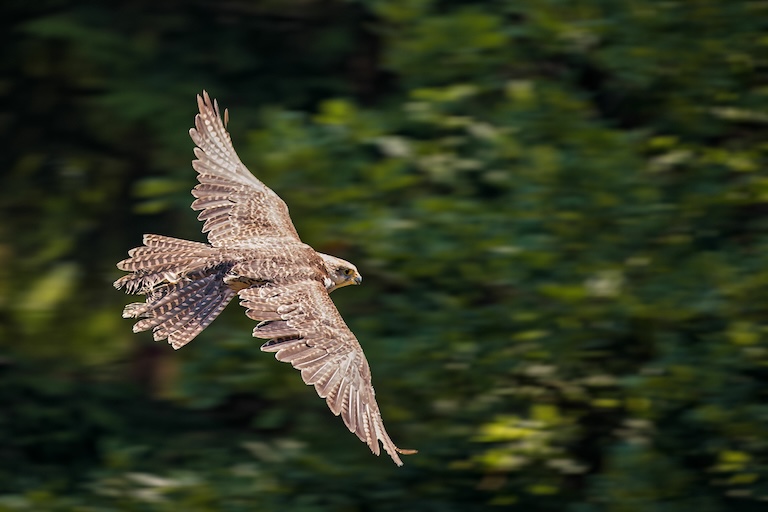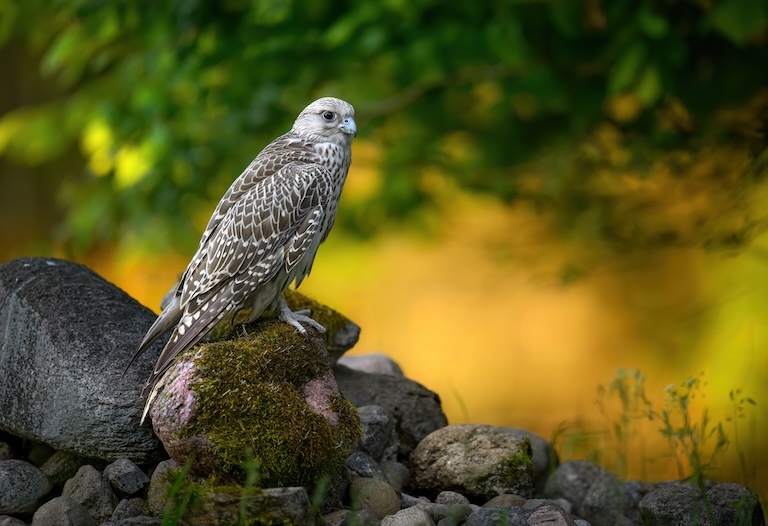Gyrfalcon Profile
Peregrine falcons are known as the fastest animals alive, able to reach alarming speeds with the help of gravity to reach phenomenal velocities and surprise their prey with a bird-shaped bullet to the head.
But a close relative has a very different and much more confrontational approach.
The bulky and incredibly powerful gyrfalcon hunts using speed too, but instead of surprise, uses brute force to bring down prey more than twice its weight.

Gyrfalcon Facts Overview
| Habitat: | Tundra, sea ice |
| Location: | North American and Eurosiberian Arctic |
| Lifespan: | Up to 14 years in captivity |
| Size: | 65 cm 926 in) long, 1.3 m (51 in) wingspan |
| Weight: | Up to 2.6 kg (6 lb) |
| Colour: | Varied, from all white to dark brown, and speckled variants in between |
| Diet: | Mostly seabirds, ducks and geese; also mammals: hares, squirrels, lemmings |
| Predators: | Occasionally hunted by golden eagles |
| Top Speed: | 208 km/h (130 mph) |
| No. of Species: | 1 |
| Conservation Status: | Least Concern (IUCN) |
Gyrfalcons are huge, yet elusive Arctic raptors, adept at hunting in the tundra, and growing to the sizes that are more commonly found in buzzards.
This mass brings with it a huge amount of power, and they can tackle animals as large as arctic hares and geese.
Their remote habitats and unusual plumage have granted them legendary status in the world of falconry, but for the Arctic fauna, they’re just one of a number of elite predators who pose a threat.
Interesting Gyrfalcon Facts
1. They’re true falcons
The raptor world is rife with confusing common-naming schemes, and it doesn’t help that the taxonomy for many species changes over time as new information comes out.
But it can be said with relative confidence that the gyrfalcon (just like the pigeon hawk) is a true falcon.
But the Latin name doesn’t help matters; it’s possible that the Gyr- prefix stems from the Germanic word for vulture, and this might have something to do with the gyrfalcon being significantly larger than what’s typically associated with falcons.

2. They’re bigger than a buzzard
Buzzards, often called hawks by Americans (they’re not true hawks), are large raptors. Perhaps not quite as huge as some of the eagles and certainly smaller than vultures, but they can carry their own.
Falcons, on the other hand, are generally petite and eat tiny things the larger raptors would sniff at.
But not the gyrfalcon. This is the largest falcon in the world, and not only is it the size of a buzzard, it’s up there with the largest buzzard species. Males can weigh upwards of 1.3 kg, and females are even bigger, with the largest outlier hitting 2.6 kg in mass.
Compared with the buzzard, it can be distinguished by the pointed, falcon-like wings, and compared with the peregrine falcon, it’s got wider wings a longer tail, and up to a kilo more muscle. This changes several things.
First off, it’s not as fast as the lightning bolt peregrine, but this doesn’t make it a slow bird.
3. They’re fast
Peregrines are known as the fastest animal on Earth, and they hunt by diving down from incredible heights and smacking the crap out of their target at nearly 400 km/h.
A huge falcon like the gyrfalcon won’t reach speeds this insane, but they can also dive, and they still hit speeds of more than 200 km/h. But unlike the peregrine, more often than not, they engage with their prey knowing full well it can see them. 1
4. They chase their prey
Eagles are notorious for using their superior size to steal kills off smaller birds.
Falcons might stoop at high speed to take prey by surprise, but the large gyrfalcon prefers to engage in a dogfight, chasing its victim at low altitude, either in the air or along the ground.
Most of the time this is a hare or a ground squirrel, but often it’s a small bird. Not only will these cold weather specialists hunt across vast tundra, but they also spend significant amounts of time at sea, living on frozen sea ice.
The long chase is a great way to take prey that’s their size or smaller, but this brute of a bird can kill animals much larger, too. 2

5. They can kill geese
A few years ago, an international media law was passed that dictates all clips of gyrfalcons hunting need to be set to overly dramatic music.
Sadly, this means you now have to watch videos of them stooping on mute, but the good news is that there are still plenty to watch.
While the preferred hunting method of the gyrfalcon might be a tail chase, they can still drop out of the sky at an alarming speed, and the extra mass makes them less like a peregrine bullet and more like a cannonball.
And when a cannonball meets a Canada goose, the ball wins. If it’s in flight, it can be stunned for killing later on the ground. If it’s already on the ground, a 200 km/h strike by a 2.6 kg bird could certainly turn the contact point to mush.
This works on prey of up to 4.5 kg, and both males and females can make short work of large animals like this. 3 4
6. They’re the “Bird of Kings”
This falcon was recently discovered to spend time out on the sea ice, but even on land, it’s a high Arctic specialist.
Its white plumage and elusive, inaccessible habitats – and of course, its huge size – have made it a bit legendary in the falconry community; a community that has existed for over 4,000 years.
The majority of traditional falconry was practised in the Middle East, so an Arctic bird like this is even more special. It’s said that in the Middle Ages, some countries declared that only a king could hunt with a gyrfalcon.
Today, they’re still popular and are often collected illegally, but the global population is currently listed as of Least Concern by the IUCN.

Gyrfalcon Fact-File Summary
Scientific Classification
| Kingdom: | Animalia |
| Phylum: | Chordata |
| Class: | Aves |
| Order: | Falconiformes |
| Family: | Falconidae |
| Genus: | Falco |
| Species: | rusticolus |
Fact Sources & References
- Vance A. Tucker (1998), “Diving Speeds and Angles of a Gyrfalcon (Falco Rusticolus)”, Journal of Experimental Biology.
- “Falco rusticolus gyrfalcon”, Animal Diversity Web.
- Xavier Morel (2021), “Gyr Falcon on Nile Goose, short version”, YouTube.
- KURT K. BURNHAM (2011), “Seasonal movements of Gyrfalcons Falco rusticolus include extensive periods at sea”, Wiley Online Library.
